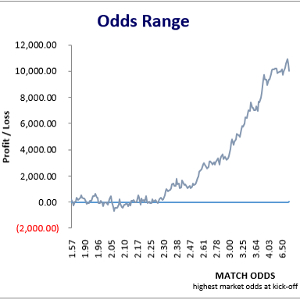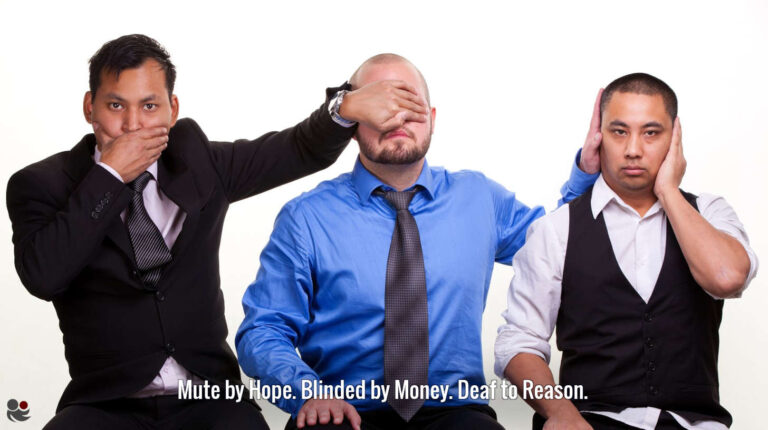
They say that the proof of the pudding is always in the eating.
Here is how a straightforward backing system made up of a portfolio of nine leagues from our Summer League HDAFU tables made over £10,000 in 178 match days from £100 level stakes during 2016.
 2016 Campaign Odds Range
2016 Campaign Odds RangeFREE Download!
2016 Summer League Campaign Workbook:
Full details of the 2016 Summer League portfolio are included in a dedicated Excel workbook, which you can download here for free. This workbook details every bet placed in all nine leagues, together with a chronological summary, the winning and losing streaks, and the parameters of each system employed.
It’s a must-have simply as a monitoring sheet template, and you will need it to understand much of what we talk about below.
Click on the following link to receive your free download via email:
Just click on the button above and then on “Continue Checkout” in the pop-up box. Enter your name and e-mail address and our store will then deliver the file to you via e-mail, free of charge. The size of the Excel file is 278KB. (Warning: Please do not apply these systems to future seasons – the parameters will certainly have changed, with each league requiring a complete re-analysis).
Note: When downloading this spreadsheet you will also receive a coupon code offering a discount of £5.00 GBP, redeemable against the purchase of any individual HDAFU Table. This allows you the opportunity to experiment and explore your first HDAFU Table without paying the full price for it and before you commit to buying more. Test drive and formulate strategies for any current season ‘on the cheap’!
Overview of the Monitoring Workbook
Summary Tab
Here you will see the 15 separate systems derived from the HDAFU tables that were pooled together as a single campaign; a well-balanced mixture of backing home wins and favourites (six systems: low risk/low return) and away wins and underdogs (nine systems: higher risk/higher return).
At the time of analysis, although there were viable systems for the draw apparent, other systems took preference. (However, several draw systems were employed in the subsequent Winter League portfolio).
You will also see that in certain leagues, we different systems were run in the first and second halves of their seasons. In other leagues, the system chosen was a better fit for the whole of the season (U.S.A., Finland and Japan).
Analysing the HDAFU tables is now a much faster exercise than ever before despite the fact that each league now comes with three separate workbooks: one to demonstrate the five full seasons approach; one limited to games in the first half of each season; one limited to games in the second half of each season.
As frequently happens, there is more than one opportunity to analyse in each of the three workbooks, but only the most promising system per league is considered for inclusion, or two if the league is split into half seasons. Read more about this approach here.
Running more than one system per league in the same market (in this case, the 1×2 market) causes confusion with conflicting betting decisions. It also means relying on something that is not the most promising in that league to help support the portfolio as a whole. With portfolio betting it is essential to field the strongest team from the start without involving any also-rans.
To mix the best performing systems with lesser ones would be like mixing apples with pears. The sweet tasting apple pie we hoped to bake would be contaminated. Always better to compare and match apples with apples.
On the whole, the time taken to analyse and then decide upon which system to support was no more than a couple of hours per league, sometimes a little more, sometimes less.
For the nine leagues represented, less than 20 hours was spent coming up with the 15 systems.
(1) Expectations Prior to 2016 Season
In columns F-P, you will see a complete breakdown of the figures the 15 systems forecasted for the 2016 season in each league.
You will also see a box entitled Possible Yield Range (Row 30). The Average Yield and Lowest Yield expected are highlighted: between 23.86% and 1.58%. This is the more realistic threshold the final result was expected to occupy.
The Highest Yield expected of 46.05% is an arbitrary figure. It is virtually impossible to achieve for the following reasons:
- It represents a cherry-picking exercise because the 46.05% figure is a synthesis of each league’s single highest profit season from the five analysed. Which season is the ‘best’ is also unlikely to be the same one in different leagues. For example, it might be the 2015 season in Japan and 2016 in Sweden.
Although there is a tiny possibility that all nine of our leagues simultaneously experience their best season in the last six in the bet types we are targeting, the statistical chance is negligible.
- The HDAFU tables are based on highest market odds at the close of the ante post market and it is extremely unlikely that you will obtain the highest odds available with every bet you place. The more realistic expectation is therefore always going to be less than the Highest Yield forecast.
- Some of the 15 systems were bound to fail although guessing which ones would was impossible to answer. This was known before the campaign began. There are several reasons for this:
- Systems were chosen which showed a historical profit in at least four of the five seasons analysed. Even with a system based on five seasons’ profit, there would still be chance of it failing in the sixth season.
- The league may experience a lower than average hit-rate in the new season. In fact, the coming season may be an anomalous one altogether. For example, it records the worst hit-rate for home wins in the last 10 seasons. Without the need for a complicated mathematical calculation it can be said right away that there is a basic one in 10 chance of this occurring, and 10% is 10%, not zero.
The more leagues and systems used, the more times this chance is faced and 10-year record highs and lows have to be set sometime. Of course, if we narrow things down and say that the league records its worst set of home wins in the next season (the sixth: the one after our five seasons’ analysis), the chance of the new season being the worst of the last six is a basic one in six (16.67%).
Likewise, for a bet type to record its best results for 10 seasons, the chance is again 10%, and 16.67% in the last six seasons.
Of course, the reality of the overall performance is likely to be somewhere in the middle (a standard distribution bell curve). Not all systems will fail and not all will over-achieve but by picking the sweet spots in the historical results, the chances of overall success are enhanced.
- Bookmaker odds across the board may be slightly lower than usual in response to repeating trends in the match results. There are definitely some seasons where the odds setting for a particular bet type is markedly different from previous seasons. It’s not often, but it does happen. This may not influence whether a profit is made, but it will affect the size of it.
(2) Results of 2016 Season
The forecasts and the results achieved were very close.
The average forecast suggested a scenario of 849 bets with a hit-rate of 44.99%. The total eventually recorded was 825 bets (without missing a single betting opportunity) at a hit-rate of 43.52%.
But even with these fractional shortfalls, a yield of 12.17% (cell V28) equated to a profit of £10,038, with all four bet types in profit – The higher risk/higher return away wins were the star performers with a profit of £7,097 (cell Y25).
A yield of more than 12% is an excellent return. Anything over 5-6% is good. There are no savings plans that we are aware of that deliver such a large return in such a short space of time.
And if you need reminding, the money in betting is not in perennially backing home wins and favourites.
Only four of the 15 systems achieved yields in excess of their average expectations (V column cells filled in green). Three of these (plus another two) achieved hit-rates in excess of the five season average (T column cells filled in green).
Overall, it was not an exceptional performance (it didn’t need to be), but it was a carefully planned one. It flew the mission, hit the objective and came back in one piece. The system avoided the bookmakers’ radars with a relatively small stake of £100 per bet. (Limited by the size of our initial bankroll).
A 10k return and a bankroll which was luckily in profit from bet number 1 (and remained so until the end – see Chrono tab), was immensely satisfying, and when all was totted-up the earnings came to around £70 tax-free per hour of time invested in the project. Everything will be quicker and slicker next time…
Aftermath – Why did Some Systems Fail?
Going back and trying to figure out why things went wrong is an integral part of any betting system. It helps allay fears that perhaps you did something wrong – if you did, hopefully you’ll find the error. It’s not about creating excuses for failure; it’s more about peace of mind and learning lessons for the future. Life is all about continuing to learn.
Getting the calculations correct when formulating the systems is fundamental. If theories are based on misleading information to begin with, you are sunk before you start betting.
Here is the post-mortem:
Brazil – Série A
It was a strange season in Brazil.
The crowd plays a hugely important role in football matches. We’ve all heard of ‘partisan atmospheres’, especially during local derbies.
Following the undoubted rise in popularity in the game caused by hosting the World Cup in 2014, average attendances rose to a six year high of 17,160 per match in 2015 and then instantly fell by almost 10% to 15,809 in 2016. Increasing crowd violence and rising admission prices were held to blame.
It is difficult to say how much of an influence the crowd effect has on a season, but it was certainly an anomaly in 2016.
On top of this, results were also skew-whiff. The 2016 season saw 53.30% home wins. During 2011-13, this figure was around 48%; 2014 = 51.84%; 2015 = 52.63%. The differences between these figures do not seem great, but in 2016 there were 202 home wins, almost 20 more than in any of the seasons 2011-13.
Whilst the first half season system based on home wins brought a profit, the home win anomaly detrimentally affected the underdog system in the second half of the season. The away win percentage (mostly underdogs) only hit 21.9% in the second half of the season, a six season low.
However, the fact remains that the second half season underdog system was only one win away from turning a profit. If any one of the 21 lost bets had come in, there would have been profits across the board in Brazil.
Instead, it was just a case of bad luck. The majority of expected home wins were in the second half of the season, when the preference was for the other way around.
Norway – Tippeligaen
The second half of the season was miserable. It was tempting to pull the plug on this system at one stage, especially when it became obvious that this system would fail.
But, the point of all of these systems is to hold firm and play them through to the end. Compare what happened in Norway with the last round of games in Japan where all five bets won. This is another example of synergy – the Norway losses were recovered elsewhere in the grand scheme of things.
Norway recorded its lowest home win rate for six seasons and by more than 2%. This equates to six wins short of the lowest total in any of the previous five seasons, which in a 240 game season, is a big deviation.
In the first half of the season, the incidence of home wins was 50.51%, with only 26.26% away wins. In the second half, when home wins were targeted, the rate dropped to a miserly 41.13%, whilst away wins were 31.21%. Like Brazil’s two systems, Norway’s results were precisely the wrong way around again.
Norway was certainly anomalous as it produced the lowest home win rate in 2016 of any season since 2004. That 10% chance mentioned earlier came in here.
You’ll see from the HDAFU tables (if you buy them!) that the Norwegian mid-season break (like Sweden) is around a third of the way into each season. The fact is that the season halves are disproportionate. Most of our bets were in the larger second half programme.
Perhaps in future it will be a better idea to use a whole season analysis (i.e. dispense with the split season approach) in all leagues where the season halves are disproportionate.
Singapore – S-League
This was a lesson in gut-feeling. This system was taken on board largely due to previous successes in this league.
The 2015 S-League had turned-in a yield of 37% and profits of £4,659. It was almost in homage to this result that underdogs were chosen again in both halves of the 2016 season.
The league format in Singapore has changed dramatically recently. 2015 saw only 9 teams take part in the league, which was repeated in 2016. There were 13 teams in 2013.
The statistics used to formulate the systems here were therefore disparate. In splitting the league into halves for the first time, a mixture of apples and pears was unwittingly analysed.
The tiny loss incurred across the board was therefore a matter of luck. Okay, it was only 26 bets in total during 2016, but a small negative result wasted time that could easily have been avoided. Greed probably got in the way of the decision-making process as did the feel-good factor of winning well in previous seasons.
2017 will probably see a return to the whole season approach in this league too.
Next Page: Other Workbook Tabs and Conclusion








Hello Right Winger,
i want to ask you: in what timeframe do you usually place your system bets? Do you wait as much as possible before kick off time or you use other cryterias? I found that if one should wait for the closest possible time, with multiple championships this can be really difficult to manage. However, i also found that odds (even higher odds) tend to change frequently during the last hours pre kick off. So i am curious about how do you manage this particular matter.
Thanks for your time!
Hello again Daniele,
We place the bets always within the last hour before kick-off. Our analysis is based on odds at close of the ante post market, and we want to operate as close to this benchmark as possible to be true to our analysis.
The odds do fluctuate a lot in some cases as soon as team news is released, which is usually an hour or less before kick-off time.
If a price is within our threshold inflection points, we place the bet regardless.
If it is close to the inflection points but not quite in the threshold, we request a price that is high enough to place the odds within our threshold using betting exchanges (of course calculating net of the exchange’s commission rate).
Yes, it is hard work, and a lot of attention to detail is required but if you want the best fruits, you have to climb the trees, as they say…
hello,
how can i find in this example excel file can i buy from u or i need to create myself like u?
Zin,
Sorry, I’m not sure I understand the question. If you want to buy any of the 14 Summer League Excel files (you get three for each league), then you can buy them here.
hi,
may i know how u calculate the average highest profit and lowest profit in summary tab in excel?
Hello again Zin,
Highest is as stated a purely arbitrary figure made up of the synthesis of the highest single season in each league. As this is not necessarily the same season in each league, it represents only what is possible if the neglible chance does in fact transpire. In other words, if every one of our systems hits a 6-season high in the new season. You will agree this is pretty unlikely.
Lowest is exactly the same as the highest, but in reverse.
Average is the more realistic target.
I hope this helps.
Hi Right Winger,
I read the article and detected my mistake. It was wrong filtering, To filter data I relied on graph helper columns in Inflection points tab. Now I filtered Paraguayan tables right and wrong ways and in the latter zero odds were 3.016. 0.01 difference compared with correct 3.006, but once I redo Japan and Ireland I should find much larger deviations, since every possible strategy I considered have zero odds somewhere in between of my targeted odds range, not below. HDAFU user guide was really helpful to understand how to filter data and what to look for (zero odds lower than first inflection point value), without it I would’ve gone wrong.
I mean I sorted data and results indicate that betting exactly same bet types and odds ranges in the 2017 season you bet in 2016 of Ireland and Japan leagues would still work well. But at the end of this article you said that odds parameters change every season and they would not work in the next season. This is what confused me. Thanks for the link, I didn’t see those updates yet. I will read it carefully, but after quick look I’m sure I managed to do everything like it’s explained in the article. The only thing I didn’t do is I didn’t include favourites and underdogs odds in the sorting, but since I didn’t care about backing them, I suppose sorting results didn’t go wrong?
Hi Right Winger,
in the end of the article you said that bet types for the next season might remain the same, but odds parameters change every season. After doing my own analysis for the next season of Ireland and Japan I found out that not only the bet types, but also odds ranges can virtually remain the same. It’s only the the bottom of the range that barely changed – like 0.01. The top of the range can be shorter, the same or longer odds than it was in the last season, but I would be fine either way. Of course, yield, ROI and number of bets differ noticeably. Some systems with shorter or longer top odds would provide better yield and ROI, but bottom odds of the range are virtually the same. I read your words, stare at the numbers I came up to, and find myself confused. Maybe you have a comment about it…
Hello again Jo,
I am not 100% sure what you mean by, “After doing my own analysis for the next season of Ireland and Japan I found out that not only the bet types, but also odds ranges can virtually remain the same.”
Perhaps look at our HDAFU Table User Guide article for the definitive way of analysing the tables.
If you are looking at Japan and Ireland from the perspective of comparing the 2016 HDAFU table with the 2017 table, then look at only the whole season analysis in the latter. Compare the two tables using the methods outlined in the User Guide, and then let me know what you think.
Good luck and thanks for your question.
Hi Zinphyosein,
This is system betting, with value always on your side.
The approach is more fully explained in our User Guide article.
Thanks for your question!
hi , may i know if this is so called value betting or system betting?
Hello Jo,
With the progressive nature of the system, we will set ourselves bankroll growth targets.
For example, if the bankroll grows by +5%, stakes will increase by +5% until the next target is met.
Of course, the stop-loss mechanism is driven to some extent by the stake ratchet and the bankroll growth. Revised stop-loss financial thresholds need setting as soon as stakes are adjusted upwards.
When the system isn’t going forwards, the stop-loss mechanism will provide some insulation against losses. It works in reverse to the growth method. Setting of this figure may also depend upon the nature of each system: low risk/low return or high risk/high return – for us probably set at 45% and 30%, respectively.
Of course, it goes without saying that each individual system within our portfolio will be managed on its own criteria. Setting of starting bank for each system is done according to maximum expected losing streak.
But honestly, it’s about personal choice, the size of your starting bank, the size of your initial stakes, your attitude to risk, the balance of your portfolio, and yes, you’re right – I could fill an article with thoughts on this!
Thanks for your question Jo, and for your valuable custom.
I am very interested in knowing the criteria for managing the starting bankroll. It seems that the campaign described in this article was managed using a single bankroll, yet now you said that it is advised to split the bankroll according to every single system. That would mean that if a single system exceeds the forecasted maximum losing streak, it’s bankroll goes to 0 and the system failed, with no need to continue betting on it. Is that the approach you are suggesting? So let’s say that one of my systems have a predicted maximum losing streak of 8. I decide to set the bankroll for this particular system to 10 units accordingly. If the balance of this system reaches 0 before the end of the season i stop the betting associated with it and focus on the other systems. That approach leaves room for a very limited numbers of systems. Some systems may have losing streaks of 20, 30. You had 15 systems in your campaign, and based on this assumptions the initial bankroll could have easy exceeded 10000£, based on the 100£ units described. If you have to run a winter leagues systems parallel to this, that can double the amount (again, choosing just a limited amount of systems).I guess this is the slowest and safest course of action to be protected against bad runs. I am curious though if thanks to the synergies from the other systems this can be pushed a little bit more to be able to include more systems/betting opportunities. That would work better without splitting the main bankroll system to system but then again some kind of calculation would be required to monitor the growing risk of adding new systems. I would really be interested in reading an article from you talking about setting up and managing your bankroll for this type of strategy. As we can convene that managing your bankroll is a vital, if not the most important, part of the business.
Hi Daniele,
Thanks for the many questions!
Yes, the 2016 campaign was based on flat stakes and the starting bank was less than £2,500.
Now we have a larger starting bank, what we are doing in 2017 is employing both a stop-loss and ratchet system to make more of our money going forwards.
Starting off with flat stakes in each system again, we have bankroll growth targets in each system. Once bankroll has increased by 5%, stakes will be increased by 5%. If the bankroll reaches 10% growth from the starting figure, we will ratchet-up the stakes again to 110% of the original figure, and so on.
Likewise, we will employ a stop-loss at the other end to reduce losses such as our Norway example. It will work in complete reverse to the ratchet system. If the system is failing, the stakes will therefore become progressively smaller to reduce the risk to the overall portfolio. It’s effectively a layer of insurance.
Our entire bankroll is quantified by the maximum losing streak of the riskiest system. For example, if we start off staking 100 units per bet, and the riskiest system shows a predicted maximum losing streak of 15, then our overall portfolio bankroll will be set at 2-3 times this amount (depending upon personal preference and balance of your portfolio). Say our portfolio has a healthy balance of low risk, medium risk and high risk systems. Maximum losing streak in our riskiest system is 15. Stake is 100 per bet. 100 x 15 x 2 = 3,000 unit starting bank.
Preferably, you should maintain a healthy balance of risk in your portfolio. Choose a higher multiplier if you need extra reassurance or security. 100 x 15 x 3 = 4,500 starting bank.
Because of the synergy factor it is literally impossible to lose your entire bankroll if you have a large enough portfolio (at least 500 bets in the campaign), a healthy balance of risk within it, and an adequate starting bank. (Plus the discipline to stick to the game plan).
With regards to allocating the starting bank per system, we were unable to do this properly during 2016 due to the relatively small size of our starting bank. In the new season, we will employ more systems, but the starting stake will be the same 100 units – although the starting bankroll is larger, it will have to cope with larger numbers of bets, and we need to ensure we always have enough money in our bookmaker accounts to feed the portfolio.
We therefore apply nominal starting bankroll values to each system based on the maximum losing streak of that system. In other words, these are paper figures which set the thresholds for managing each system with the ratchet and stop-loss mechanisms. They do not represent proportions of the actual starting bankroll but merely act as guides as to when stakes should be increased and when they should be reduced.
This is a difficult concept for some people to understand but when your bankroll isn’t large enough to physically allocate proportionately to each system, then having a virtual bankroll for each system is the only way of managing it.
You mention considering systems with up to a maximum of 30 losing bets in a row. Personally speaking, we look for systems under losing streaks of 20. We want the portfolio to be as tight as possible. The synergy effect is lessened by including systems with losing streaks as high as 20 and beyond. The portfolio gets too stretched and the lower risk supporting bets have trouble making up for the greater losses in the higher risk systems.
Phew, a long answer, but I hope this helps!
Hi Right Winger,
I suppose it would take a separate article to clarify that, but can you at least give some comments about your stake management tweaks you’re going to implement in the next season? How you’re going to set those limits when stakes will be reduced and vice versa?